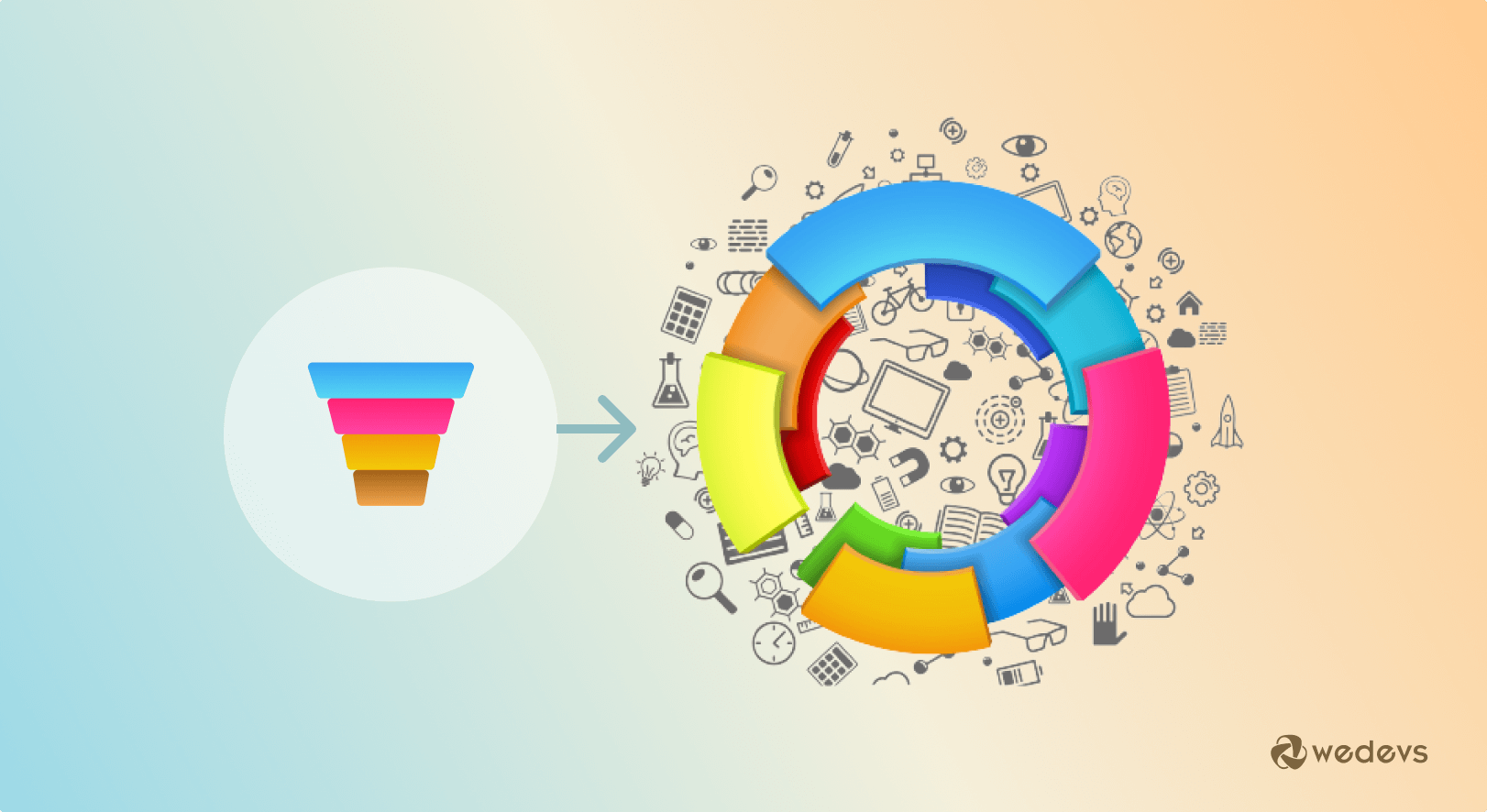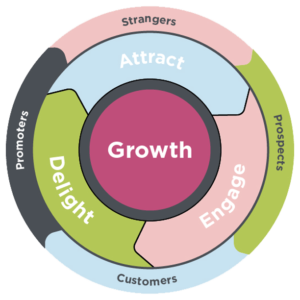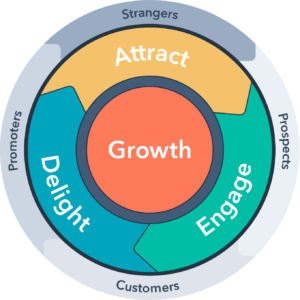
The Sales Flywheel Revolution: Learn Everything to Ensure Business Success in 2024
The main fuel of a successful business is happy customers and the sales flywheel is a powerful tool for creating happy customers.
The sales flywheel is a cyclical process by which happy customers lead to more customers and increases revenue over time.
Customer demands have been changing in the last few years due to technological advancements, changing lifestyles, and increased access to information. Now, most people prefer personalized experiences, products, and services that cater to their specific needs.
Companies are also shifting from their old methodologies to match modern customers' needs.
Previously, businesses used the sales funnel method to better map a customer's journey so they can make quick adjustments if needed. But as customers become the cornerstone of a business, this approach is not appropriate for today's world. To make a bridge between customers' needs and business activities, experts introduced the concept of “Sales Flywheel”.
In this blog, we'll show you how you can take your business to new heights with the help of a sales flywheel.
Let's start from the beginning-
The Definition of Sales Flywheel
Sales Flywheel is a self-sustaining marketing model. In this model, businesses keep customers at the center of their business activities. Customers' needs get the highest priority here which strengthens the bond between companies and buyers.

In 2001, Jim Collins the writer of “Good to Great” first introduced the concept of flywheel marketing. Basically, the flywheel analogy refers to the idea that, like a flywheel, a business's sales process gains momentum with each turn, and eventually requires less effort to maintain.
The concept of sales flywheel is often associated with inbound marketing and customer-centric business models. It prioritizes long-term relationships and customer satisfaction over short-term achievements.
The Concept of Sales Flywheel is Similar to a Flywheel Engine
The concept of sales flywheel comes from the real-life flywheel engine.
A Flywheel engine produces energy with the rotation of the shaft. Then uses this energy to power the engine's pistons and drive other mechanical components. As the engine continues to operate, the flywheel builds momentum. This process ensures a consistent level of energy output over time.

Similarly, in a sales flywheel, a business stores energy in the form of customer relationships and positive customer experiences. This energy can be used to drive future sales and generate new leads through word-of-mouth referrals and other customer-driven marketing channels.
As the business continues to acquire and retain customers, the sales flywheel gains momentum. With this momentum, you can generate new opportunities and maintain a steady stream of revenue over time.
Key takeaway: Inside the flywheel model, you can use the momentum of your happy customers to drive repeat sales and boost customer retention. This keeps your business growing.
Why Sales Flywheel is The Marketing Concept of the New Age?
Every day a large number of people enter online businesses. In fact, digital presence is a must for any type of business that has physical shops. If your business isn't online, you are missing out on an untapped, free resource to build your brand.
With this explosion of online businesses, a lot of opportunities arise. At the same time, it increases the competition as well.
To sustain in this competitive industry, you need a loyal customer base.
This is the main reason, businesses now put their best efforts to create happy customers and boost loyalty. As loyal customers do your brand advocacy and keep your revenue wheel spinning. And here sales flywheel comes into play.

As you can see, Amazon flywheel provides a great customer experience at reasonable prices. It creates happy customers who are more likely to come back – thus pushing the cycle!
Typically, a sales flywheel works to create satisfied customers. The key components of a sales flywheel include-
- Acquiring customers
- Delivering a positive customer experience and
- Leveraging that experience to generate more sales and referrals.
The sales flywheel helps you create a continuous loop of customer acquisition and retention. And as you know, it requires less time and effort to sell products to repeat customers than new customers.
On the other hand, word-of-mouth marketing is one of the most effective forms of marketing to influence purchasing decisions.
In a nutshell, a flywheel's main goal is to ensure that you take good care of your existing customers over the long run. So, you can create more happy customers that bring you more revenue. As a result, your flywheel can spin faster and your business will expand.
How Does A Sales Flywheel Actually Work?
Your sales funnel needs energy and momentum to spin on its axis. There are 3 core factors here-
- How fast do you spin it?
- How much friction there is?
- How big it is?
To make your flywheel spin faster, you need to adjust your business strategies. Add force to the required areas that will increase the speed of your flywheel. You can imply several strategies to speed up your flywheel. Such as inbound marketing, giveaways, customer referral programs, paid advertising, and quick after-sale services. These steps will work as forces to spin your flywheel faster.
Applying force to your flywheel is not your only duty, you have to reduce all negative energy as well. So, nothing can oppose it. Remove all frictions from your business strategy. Friction can be anything that may slow down your flywheel.
Such as poor team bonding, lack of proper communication channels among different teams, inappropriate distribution channels, or misalignment between your customers and your employees. You can eliminate these frictions by focusing on proper team structure, creating easy communication channels for both employees and customers, giving open space for sharing experiences, etc.
The more you can increase speed and reduce friction, the more you'll get loyal advocates for your brand. And these advocates work as a force to spin your flywheel.
The Three Phases of Sales Flywheel
The sales flywheel has three phases: attract, engage, and delight.
In the attract phase, businesses focus on creating valuable content and experiences to attract new prospects to their brand. Don't force people to draw their attention. Rather you can move smartly with smart marketing strategies. Such as content marketing, search engine optimization, social media marketing, conversion rate optimization, and so forth.

In the engage phase, they work to build relationships with those prospects. Make it convenient for your users to communicate and buy from you. Your main aim has to be building relationships, not just closing deals. Some forces that you can implement in this stage like sending personalized emails, customer clustering, personalized Facebook campaign, multichannel communication (chat, phone, messaging, email), free demo, multiple payment gateways, nurturing leads, and others.
Finally, in the delight stage, businesses strive to provide exceptional customer service and experiences to build loyalty and encourage customers to refer others. Some forces you can apply here such as automated service (eBook, chatbot), proactive customer service, ticketing systems, automated onboarding, customer feedback surveys, and loyalty programs.
The Limitations of Sales Flywheel
The sales flywheel is no doubt a powerful framework for accelerating business growth. However, it does have some limitations. Here are a few to consider:
- Implementation challenges: Implementing a sales flywheel requires a significant amount of effort and coordination across different teams, which can be difficult to achieve in organizations with complex structures.
- Limited impact on new customer acquisition: While this method can help to increase customer loyalty and retention, it may not be as effective in attracting new customers to your business.
- Dependency on customer feedback: Success depends on customer feedback and the ability of your team to respond quickly and effectively to customer needs. If your team struggles to collect and act on customer feedback, the flywheel may not be as effective.
Overall, while this sales model has proven to be a valuable tool for many businesses, it is important to consider these limitations and evaluate whether it is the right approach for your organization.
Sales Flywheel vs. Sales Funnel: How Does the Flywheel Give Sales Teams a New Edge?
The sales flywheel and sales funnel are both useful models for understanding the process of generating and converting leads into customers. However, the sales flywheel has some advantages over the traditional sales funnel approach.
One key difference is that the sales flywheel focuses on creating a positive customer experience at every stage of the process. Whereas the sales funnel is primarily focused on moving customers through a linear path from awareness to purchase.
The sales flywheel recognizes that customer satisfaction and loyalty are critical to sustainable growth. Because happy customers can drive new business through referrals and word-of-mouth.

Also, the sales flywheel is a more iterative and dynamic model than the sales funnel. In a flywheel model, each stage of the process is interconnected and can influence the others. But the sales funnel follows a linear progression where the possibilities get narrow in every stage.
Moreover, the concept of sales flywheel allows businesses to continuously improve, refine their approach based on customer feedback and changing market conditions.
Overall, the sales flywheel offers a more holistic and customer-centric approach to building a successful business model.
Comparison Table: Sales Funnel vs Sales Flywheel
| Criteria | Sales Funnel | Sales Flywheel |
| Structure | Customers at the bottom | Customers in the center |
| Approach | The prospect goes through the funnel | Other elements surround the prospect |
| Purpose | Prospect conversion | Customer experience |
| Continuity | Start and Stop | Ongoing |
Note: We're not saying that the sales funnel is not a good approach for businesses. But the concept of the flywheel is more advanced and designed to serve modern business models. There is no doubt, modern businesses need modern strategies. It's high time, you should adopt to latest technologies.
Sales Funnel Vs Sales Flywheel: Which Is The Right Model For Your Business?
There is no doubt, happy customers are extremely crucial for modern businesses. It largely impacts a company's success and sustainability in the long term.
Even 10 years ago, companies considered selling more products as their success. But now they are more concerned about customers' happiness. As companies are realizing that customer satisfaction is key to retaining customers and building brand loyalty.
The sales flywheel helps companies improve their customer experience and increase customer loyalty. So, a company can generate a cycle of positive feedback that drives growth and revenue.
Considering the facts, it is likely that the sales flywheel model will continue to be an important concept for businesses. Leverage the power of this marketing model to drive sustainable growth through customer satisfaction and loyalty.
Is It Wise to Switch to Sales Flywheel Method for Your Business?
The sales flywheel model has become popular in recent years due to its modern approaches.
With the rise of social media and online reviews, customer loyalty has become a critical factor in building brand reputation and attracting new customers. Considering these facts, the flywheel is the perfect marketing model for today's business world. As all the parts of the flywheel largely focus on ensuring a positive customer experience.
Also, the sales flywheel emphasizes the importance of customer retention and referrals. This can lead your business to significant long-term growth and cost savings compared to constantly acquiring new customers.
You should also understand that modern customers have more choices and information than ever before. Companies are also facing ever more complex challenges to satisfy their clients. In this situation, the flywheel model helps them prioritize their customer's needs and introduce a customer-centric business approach.
Recap of Sales Flywheel:
- The sales flywheel is a cyclic approach that matches the modern business model, and the sales funnel is the traditional marketing model.
- The aim of the flywheel is to ensure a better customer experience, where the sales funnel focuses on shifting as much as customers from one stage to another.
- The flywheel focuses on growth by continuously generating prospects.
- The force that pushes the flywheel is from promoters or clients who appreciate your praises.
- Reducing friction enables the flywheel to continue rotating without being inhibited
- Inside the funnel, only businesses give their efforts to grow but for flywheel, businesses and customers work together for growth.